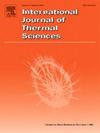Comprehensive parameter analyses on steam-air condensation at equal-height-difference natural circulation loop under large air mass fraction
IF 4.9
2区 工程技术
Q1 ENGINEERING, MECHANICAL
International Journal of Thermal Sciences
Pub Date : 2025-02-24
DOI:10.1016/j.ijthermalsci.2025.109807
引用次数: 0
Abstract
As the development of small-sized reactors progresses, a passive containment cooling system (PCCS) named equal-height difference natural circulation loop (EHDNCS) has been developed. Experiments were carried out at elevated air mass fractions to assess the condensation heat transfer coefficient (HTC) based on the steam-air mixture pressure, air mass fraction, and wall subcooling. Research indicates that as the air mass fraction increases, the HTC for condensation tends to decrease. Conversely, a higher pressure of the steam-air mixture within the containment leads to an increase in HTC. The condensation HTC increases with increasing wall subcooling; however, when the air mass fraction exceeds 75 %, the condensation HTC remains nearly constant with changes in wall subcooling. A quantitative relationship between the condensation HTC and the height of the PCCS (sum of riser height and 0.5 times heat exchanger height) has been derived by analyzing the driving force and resistance of the cooling water flow within the natural circulation loop. The optimal conditions for adjusting the riser height and the initial riser-to-heat-exchanger height ratio have been determined to enhance the heat transfer performance of the PCCS. Drawing from experimental results, an empirical correlation equation has been formulated to estimate the condensation HTC for PCCS utilizing enhanced heat dissipation through natural circulation systems (EHDNCS), with a prediction deviation within ±31 %.
求助全文
约1分钟内获得全文
求助全文
来源期刊

International Journal of Thermal Sciences
工程技术-工程:机械
CiteScore
8.10
自引率
11.10%
发文量
531
审稿时长
55 days
期刊介绍:
The International Journal of Thermal Sciences is a journal devoted to the publication of fundamental studies on the physics of transfer processes in general, with an emphasis on thermal aspects and also applied research on various processes, energy systems and the environment. Articles are published in English and French, and are subject to peer review.
The fundamental subjects considered within the scope of the journal are:
* Heat and relevant mass transfer at all scales (nano, micro and macro) and in all types of material (heterogeneous, composites, biological,...) and fluid flow
* Forced, natural or mixed convection in reactive or non-reactive media
* Single or multi–phase fluid flow with or without phase change
* Near–and far–field radiative heat transfer
* Combined modes of heat transfer in complex systems (for example, plasmas, biological, geological,...)
* Multiscale modelling
The applied research topics include:
* Heat exchangers, heat pipes, cooling processes
* Transport phenomena taking place in industrial processes (chemical, food and agricultural, metallurgical, space and aeronautical, automobile industries)
* Nano–and micro–technology for energy, space, biosystems and devices
* Heat transport analysis in advanced systems
* Impact of energy–related processes on environment, and emerging energy systems
The study of thermophysical properties of materials and fluids, thermal measurement techniques, inverse methods, and the developments of experimental methods are within the scope of the International Journal of Thermal Sciences which also covers the modelling, and numerical methods applied to thermal transfer.
 求助内容:
求助内容: 应助结果提醒方式:
应助结果提醒方式:


